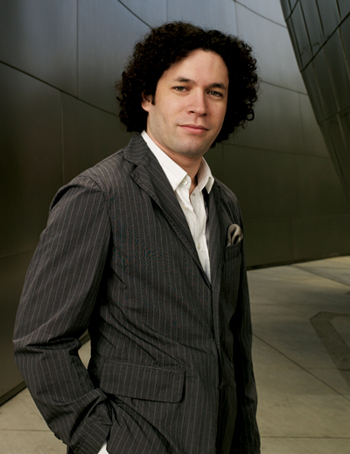Dudamel, LA Phil open stand with powerful Corigliano and austere Tchaikovsky

Gustavo Dudamel led the Los Angeles Philharmonic in symphonies of Corigliano and Tchaikovsky Sunday at Lincoln Center.
Presenting a program with two full-length symphonies is an adventurous proposition—Such a meaty program can be riveting, but one runs the risk of having one of the pieces overshadow the other, and (worse) the first half outshining the second.
Such was the case on Sunday afternoon, as superstar conductor Gustavo Dudamel led his Los Angeles Philharmonic as part of Lincoln Center’s “Great Performers” series.
The first of two forty-minute symphonies was John Corigliano’s Symphony No. 1. The New York native dedicated the piece to the memory of several friends who died of AIDS. Movement titles can be inscrutable or hard to connect to their music, but Corigliano’s need no gloss—The first movement, “Apologue: Of Rage and Remembrance,” immediately explodes with chaotic fury, the violins and violas bowing violently and independently on their open A strings.
Corigliano’s writing in this symphony is remarkable, as he uses conventional instrumentation and accessible tonality, but nonetheless presents a strong and distinctive voice through his use of color and contrast. In this first movement, strings and brass are often pitted against one another in fierce competition, their battle paused here and there by nostalgic quotations of Isaac Albéniz’s Tango.
The second movement, “Tarantella,” lives up to its name only intermittently—the movement begins with a snarl of percussion, and when the tarantella does begin it is quickly interrupted by blaring brass, a pattern that continues as the piece progresses. In later episodes the dance persists but fluctuates wildly in its tempo, seeming to run out of control. The music never got away from Dudamel, who managed to keep it under just enough rein to hold the structure together while maintaining a frantic energy.
The third movement, a chaconne, is placid in its writing, and in Dudamel’s interpretation there was just enough unease to keep it from feeling truly serene. This movement’s dedicatee was an amateur cellist, and the highlight of the entire concert was the duet here between the two principal cellists, Robert deMaine and Ben Hong. Their warm, poetic playing evoked a loving relationship between two musical characters, made all the more haunting when the duet was reprised in the finale, which revisits the themes of the earlier movements.
The only complaint that could be lodged over the performance of this symphony is a programmatic one. Though a few conductors (Alan Gilbert among them) have fought against it from time to time, there exists a widespread bias towards putting contemporary pieces on the first half of a concert, no matter their length or weight. In Corigliano’s Symphony No. 1 we have a work that is more than substantial enough to anchor a program (and by no means too alienating; the Avery Fisher crowd gave it a five-minute ovation), but protocol dictates that a symphony from the standard rep has to go on the second half.
That symphony was Tchaikovsky’s Fifth, one of his most popular, and particularly memorable for the austere motto that begins the first movement and recurs throughout the Symphony. The motto was stated calmly here, almost too calmly.
On the whole, though, the LA Phil exhibited an almost Hollywood-orchestra sort of sound; they combine pristine technique with the sort of swelling, massive, almost saccharine sound that one often—too often, probably—hears applied to Rachmaninoff. To hear that sound in Tchaikovsky was different, but certainly effective. Dudamel carved arching, shimmering phrases out of the expansive writing. He was also careful, however, saddling the bouncier sections with undue—and uncharacteristic—restraint.
That restraint of course worked well in the second movement, where the loving horn solo was repeated in the cellos with burnished tone. Even in tranquility, there was a sense of tension. The third movement, unfortunately exhibited the same caution as the first: Though not a scherzo exactly, this waltz provides a brief escape from the swelling emotions of the rest of the symphony, but this reading was more careful than carefree. This was especially true in the middle sections, where tricky runs of sixteenth notes are passed around the strings—Dudamel had his foot on the brake, so that the playing felt overly meticulous.
The finale, though, provided a satisfying conclusion, with its august restatement of the motto that launches into a full allegro with a burst of fury. Here, Dudamel exhibited a firm sense of the piece’s flesh, drawing rich support from the secondary voices and guiding the piece to a commanding finish with broad, sweeping grandeur.
Another roaring ovation ensued, and the Philharmonic responded with the Polonaise from Eugene Onegin, playing with a delightful combination of charm and swagger.
The Great Performers series continues Monday night, as the LA Philharmonic presents Rachmaninoff’s Third Piano Concerto with Yuja Wang, Brahms’s Second Symphony, and the New York premiere of Daníel Bjarnason’s Blow Bright. Lcgreatperformers.org